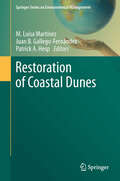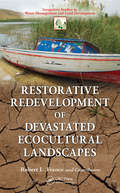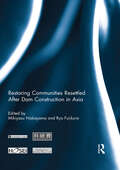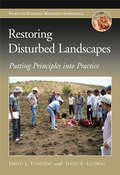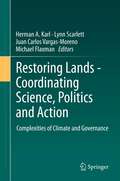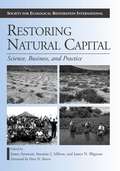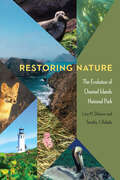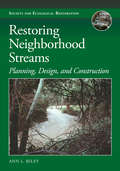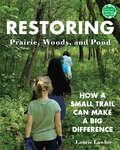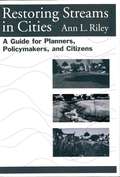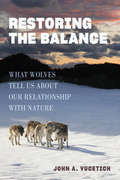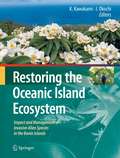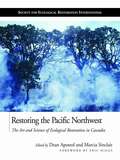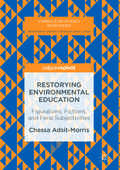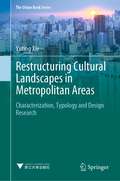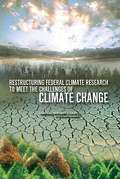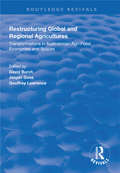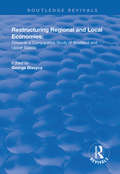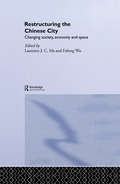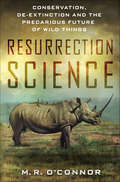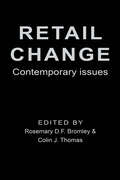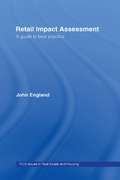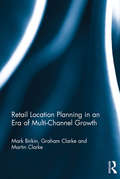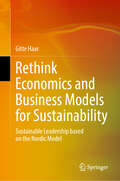- Table View
- List View
Restoration of Coastal Dunes
by Luisa M Martínez Juan B. Gallego-Fernández Patrick A. HespThe continuously growing human population along the world's coasts will exacerbate the impact of human activities on all coastal environments. Restoration activities will therefore become increasingly important. In particular, sandy shores and coastal dunes will require significant restoration efforts because they are preferred sites for human settlement, industrial and urban development and tourism. With this book experts in the field present a comprehensive review of restoration studies and activities, where 'successful' and 'failed' studies or approaches from around the world are contrasted and compared. A major asset the book provides is a compendium of studies showing that coastal dune restoration has many definitions and thus leads to many different actions. This volume addresses those with an interest in conservation ecology and biology, coastal dune dynamics and geomorphology, and coastal management who are seeking information on the different strategies for coastal dune restoration applied in different regions of the world. Finally, it will be a valuable resource for coastal scientists and planners, as well as for local and state officials, residents of coastal communities, environmental advocates and developers.
Restorative Redevelopment of Devastated Ecocultural Landscapes (Integrative Studies in Water Management & Land Development)
by Robert L. FranceA fusion of ecological restoration and sustainable development, restorative redevelopment represents an emerging paradigm for remediating landscapes. Rather than merely fixing the broken bits and pieces of nature, restorative development advocates the reuse of devastated landscapes to improve the value and livability of a location for humans at the
Restoring Communities Resettled After Dam Construction in Asia (Routledge Special Issues on Water Policy and Governance)
by Mikiyasu Nakayama and Ryo FujikuraThe rapid economic expansion and population growth of developing countries in Asia has led to increasing demands for water and energy. To meet these demands, large dam development projects have been completed, which has inevitably caused involuntary resettlement. In order to support these projects, dam developers must find appropriate ways to ensure adequate livelihood reconstruction for resettled individuals. Resettlement causes both short-term and long-term effects (both positive and negative) for the relocated populations, meaning that in order to evaluate the larger impact of such projects long-term post-project evaluations must be carried out. However, post-project evaluations by international donors have typically been conducted within a few years after completion; the long-term impact of such projects is seldom evaluated.This book aims to fill this gap. A study team composed of researchers from Indonesia, Japan, Lao PDR, Sri Lanka, and Turkey has conducted ten case studies focusing on resettled individuals satisfaction, opportunities offered, and income generation. The volume provides an overview of the ten case studies, which were carried out across five countries. It also discusses how a compensation programme should be designed and what sort of options should be presented to resettled individuals for their maximum benefit.This book was originally published as a special issue of the International Journal of Water Resources Development.
Restoring Disturbed Landscapes
by John Ludwig David J. TongwayRestoring Disturbed Landscapes is a hands-on guide for individuals and groups seeking to improve the functional capacity of landscapes. The book presents a five-step, adaptive procedure for restoring landscapes that is supported by proven principles and concepts of ecological science. Abundantly illustrated with photos and figures that clearly explain concepts outlined in the book, Restoring Disturbed Landscapes is an engaging and accessible work designed specifically for restoration practitioners with limited training or experience in the field. It tells restorationists where to start, what information they need to acquire, and how to apply this information to their specific situations.
Restoring Eden: Unearthing the Agribusiness Secret That Poisoned My Farming Community
by Elizabeth D. HilbornAll spring, Dr. Elizabeth Hilborn watched as her family fruit farm of many years became increasingly diminished, suffering from a lack of bees. The plentiful wildlife, so abundant just weeks before, was gone. Everything was still, silent. As an environmental scientist trained to investigate disease outbreaks, she rose to the challenge. Step by step, day by day, despite facing headwinds from skeptical neighbors, environmental experts, and agricultural consultants, she'd assembled information. Her observations provided a framework, a timeline to explain the evidence she'd collected. The chemicals found in her water samples showed beyond any doubt that not only her farm, but her greater farming community, was at risk from toxic chemicals that travelled with rain water over the land, into water, and deep within the soil. Hilborn was given a front row seat to the insect apocalypse. Even as a scientist, she'd been unaware of the risks to life from some common agricultural chemicals. Her goal was to protect her farm and the animals who lived there. But first she had to convince her rural neighbors of the risk to their way of life, too.A lyrical celebration of nature by a passionate citizen scientist who felt called to advocate for the land, earth, and creatures who don't have a voice, Restoring Eden ultimately offers hope that citizens can create change, that reform is possible.
Restoring Lands - Coordinating Science, Politics and Action
by Herman Karl Juan Carlos Vargas-Moreno Lynn Scarlett Michael FlaxmanEnvironmental issues, vast and varied in their details, unfold at the confluence of people and place. They present complexities in their biophysical details, their scope and scale, and the dynamic character of human action and natural systems. Addressing environmental issues often invokes tensions among battling interests and competing priorities. Air and water pollution, the effects of climate change, ecosystem transformations--these and other environmental issues involve scientific, social, economic, and institutional challenges. This book analyzes why tackling many of these problems is so difficult and why sustainability involves more than adoption of greener, cleaner technologies. Sustainability, as discussed in this book, involves knowledge flows and collaborative decision processes that integrate scientific and technological methods and tools, political and governance structures and regimes, and social and community values. The authors synthesize a holistic and adaptive approach to rethinking the framework for restoring healthy ecosystems that are the foundation for thriving communities and dynamic economies. This approach is that of collective action. Through their research and practical experiences, the authors have learned that much wisdom resides among diverse people in diverse communities. New collaborative decision-making institutions must reflect that diversity and tap into its wisdom while also strengthening linkages among scientists and decision makers. From the pre-publication reviews: "Finally, we have a book that explains how science is irrelevant without people. It's people who decide when and how to use science, not scientists. This book gives us a roadmap for how to really solve complex problems. It involves hard work, and creating new relationships between scientists and the public that don't typically exist in our society." -John M. Hagan, Ph.D. President, Manomet Center for Conservation Sciences
Restoring Natural Capital: Science, Business, and Practice (Science Practice Ecological Restoration)
by Peter H. Raven James Aronson James N. Blignaut Suzanne J. MiltonHow can environmental degradation be stopped? How can it be reversed? And how can the damage already done be repaired? The authors of this volume argue that a two-pronged approach is needed: reducing demand for ecosystem goods and services and better management of them, coupled with an increase in supply through environmental restoration. Restoring Natural Capital brings together economists and ecologists, theoreticians, practitioners, policy makers, and scientists from the developed and developing worlds to consider the costs and benefits of repairing ecosystem goods and services in natural and socioecological systems. It examines the business and practice of restoring natural capital, and seeks to establish common ground between economists and ecologists with respect to the restoration of degraded ecosystems and landscapes and the still broader task of restoring natural capital. The book focuses on developing strategies that can achieve the best outcomes in the shortest amount of time as it: * considers conceptual and theoretical issues from both an economic and ecological perspective * examines specific strategies to foster the restoration of natural capital and offers a synthesis and a vision of the way forward Nineteen case studies from around the world illustrate challenges and achievements in setting targets, refining approaches to finding and implementing restoration projects, and using restoration of natural capital as an economic opportunity. Throughout, contributors make the case that the restoration of natural capital requires close collaboration among scientists from across disciplines as well as local people, and when successfully executed represents a practical, realistic, and essential tool for achieving lasting sustainable development.
Restoring Nature: The Evolution of Channel Islands National Park (America’s Public Lands)
by Lary M. Dilsaver Timothy J. BabalisOff the coast of California, running from Santa Barbara to La Jolla, lies an archipelago of eight islands known as the California Channel Islands. The northern five were designated as Channel Islands National Park in 1980 to protect and restore the rich habitat of the islands and surrounding waters. In the years since, that mission intensified as scientists discovered the extent of damage to the delicate habitats of these small fragments of land and to the surprisingly threatened sea around them. In Restoring Nature Lary M. Dilsaver and Timothy J. Babalis examine how the National Park Service has attempted to reestablish native wildlife and vegetation to the five islands through restorative ecology and public land management. The Channel Islands staff were innovators of the inventory and monitoring program whereby the resource problems were exposed. This program became a blueprint for management throughout the U.S. park system. Dilsaver and Babalis present an innovative regional and environmental history of a little-known corner of the Pacific West, as well as a larger national narrative about how the Park Service developed its approach to restoration ecology, which became a template for broader Park Service policies that shaped the next generation of environmental conservation.
Restoring Neighborhood Streams: Planning, Design, and Construction (The Science and Practice of Ecological Restoration Series)
by Ann L. RileyThirty years ago, the best thinking on urban stream management prescribed cement as the solution to flooding and other problems of people and flowing water forced into close proximity. Urban streams were perceived as little more than flood control devices designed to hurry water through cities and neighborhoods with scant thought for aesthetics or ecological considerations. Stream restoration pioneers like hydrologist Ann Riley thought differently. She and other like-minded field scientists imagined that by restoring ecological function, and with careful management, streams and rivers could be a net benefit to cities, instead of a net liability. In the intervening decades, she has spearheaded numerous urban stream restoration projects and put to rest the long-held misconception that degraded urban streams are beyond help.What has been missing, however, is detailed guidance for restoration practitioners wanting to undertake similar urban stream restoration projects that worked with, rather than against, nature. This book presents the author's thirty years of practical experience managing long-term stream and river restoration projects in heavily degraded urban environments. Riley provides a level of detail only a hands-on design practitioner would know, including insights on project design, institutional and social context of successful projects, and how to avoid costly and time-consuming mistakes. Early chapters clarify terminology and review strategies and techniques from historical schools of restoration thinking. But the heart of the book comprises the chapters containing nine case studies of long-term stream restoration projects in northern California. Although the stories are local, the principles, methods, and tools are universal, and can be applied in almost any city in the world.
Restoring Prairie, Woods, and Pond: How a Small Trail Can Make a Big Difference (Books for a Better Earth)
by Laurie LawlorA small town with few resources comes together to restore nature and create a valuable resource for the entire community in this inspiring middle grade nonfiction book.Restoring Prairie, Woods, and Pond is about activism at the community level—and tells how a small village transformed a city-owned dumping ground into a nature trail with three distinct ecosystems that runs from an elementary school to a public library and community center. Filled with beautiful photos the book will explain how this trail became a valuable outdoor classroom during covid, a STEM teaching center, a respite for people young and old, and a place for community engagement.Books for a Better Earth are designed to inspire children to become active, knowledgeable participants in caring for the planet they live on.
Restoring Streams in Cities: A Guide for Planners, Policymakers, and Citizens
by Luna B. Leopold Ann L. RileyConventional engineering solutions to problems of flooding and erosion are extremely destructive to natural environments. Restoring Streams in Cities presents viable alternatives to traditional practices that can be used both to repair existing ecological damage and to prevent such damage from happening.Ann L. Riley describes an interdisciplinary approach to stream management that does not attempt to "control" streams, but rather considers the stream as a feature in the urban environment. She presents a logical sequence of land-use planning, site design, and watershed restoration measures along with stream channel modifications and floodproofing strategies that can be used in place of destructive and expensive public works projects. She features examples of effective and environmentally sensitive bank stabilization and flood damage reduction projects, with information on both the planning processes and end results. Chapters provide: background needed to make intelligent choices, ask necessary questions, and hire the right professional help history of urban stream management and restoration information on federal programs, technical assistance and funding opportunities in-depth guidance on implementing projects: collecting watershed and stream channel data, installing revegetation projects, protecting buildings from overbank stream flowsProfusely illustrated and including more than 100 photos, Restoring Streams in Cities includes detailed information on all relevant components of stream restoration projects, from historical background to hands-on techniques. It represents the first comprehensive volume aimed at helping those involved with stream management in their community, and describes a wealth of options for the treatment of urban streams that will be useful to concerned citizens and professional engineers alike.
Restoring the Balance: What Wolves Tell Us about Our Relationship with Nature
by John A. VucetichWolves on a wilderness island illuminate lessons on the environment, extinction, and life.For more than a quarter century, celebrated biologist John Vucetich has studied the wolves, and the moose that sustain them, of the boreal forest of Isle Royale National Park, an island in the northwest corner of Lake Superior. During this time, he has witnessed both the near extinction of the local wolf population, driven largely by climate change, and the intensely debated relocation of other wolves to the island in an effort to stabilize and maintain Isle Royale's ecosystem health. In Restoring the Balance, Vucetich combines environmental philosophy with field notes chronicling his day-to-day experience as a scientist. Examining the fate of wolves in the wild, he shares lessons from these wolves and explains their impact on humanity's fundamental responsibilities to the natural world. Vucetich's engaging narrative and unique, clear-eyed perspective provide an accessible course in wolf biology and behavioral ecology. He tackles profound unresolved questions that will shape our future understanding of what it means to be good to life on earth: Are humans the only persons to inhabit Earth, or do we share the planet with uncounted nonhuman persons? What does a healthy relationship with the natural world look like? Should we intervene in nature's course in order to care for it? Touching on the triumph and tragedy of how wolves kill moose to the Shakespearian drama of wolves' social lives, Vucetich comments on ravens, mice, winter ticks, and even a life-changing encounter he shared with a toad. Vucetich produces exquisite insight by masterfully connecting his observations to a far-reaching history of ideas about the environment. Combining natural history and memoir with fascinating commentary on humanity's relationship with nature, Restoring the Balance evokes our connections with wolves as fellow apex predators, demonstrating how our shifting views on nature have implications for both their survival and ours. This book will be treasured by any thoughtful reader looking to deepen their relationship with nature and learn about the wolves of Isle Royale along the way.
Restoring the Oceanic Island Ecosystem
by Isamu Okochi Kazuto KawakamiThe Bonin (Ogasawara) Islands, part of a remote Japanese archipelago, are a typical hot spot of biological invasion. Indigenous fauna and flora, which had long evolved in isolation, suffered devastating deforestation and invasion by multiple alien species in the twentieth century. Studies on the impacts of green anoles, flatworms, goats, cats, black rats, and tree and shrub species, among others, have led to new policies in an attempt to arrest the irreversible damage to the island biota. This book provides an overview of the research findings and countermeasures necessary for the successful management of island ecosystems. Based in research conducted over multiple species, this work provides scientists, researchers, students, and policy makers a unique perspective on the integration of conservation projects running simultaneously in the Bonin Islands and on the diversity of their impacts. Restoring ecosystems through the management of alien species is an important conservation issue and the dream that prompted this book.
Restoring the Pacific Northwest: The Art and Science of Ecological Restoration in Cascadia (Science Practice Ecological Restoration)
by Eric Higgs Marcia Sinclair Dean ApostolThe Pacific Northwest is a global ecological "hotspot" because of its relatively healthy native ecosystems, a high degree of biodiversity, and the number and scope of restoration initiatives that have been undertaken there. Restoring the Pacific Northwest gathers and presents the best examples of state-of-the-art restoration techniques and projects. It is an encyclopedic overview that will be an invaluable reference not just for restorationists and students working in the Pacific Northwest, but for practitioners across North America and around the world.
Restorying Environmental Education
by Chessa Adsit-MorrisThis book examines a performative environmental educational inquiry through a place-based eco-art project collaboratively undertaken with a class of grade 4-6 students around the lost streams of Vancouver. The resulting work explores the contradictions gathered in relation to the Western educational system and the encounter with "Other" (real and imaginary others), including the shifting and growing "self," and an attempt to find and foster nourishing alliances for transforming environmental education. Drawing on the work of new materialist theorists Donna Haraway, Rosi Braidotti, and Karen Barad, Adsit-Morris considers the co-constitutive materiality of human corporeality and nonhuman natures and provides useful tools for finding creative theoretical alternatives to the reductionist, representationalist, and dualistic practices of the Western metaphysics.
Restructuring Cultural Landscapes in Metropolitan Areas: Characterization, Typology and Design Research (The Urban Book Series)
by Yuting XieThis book introduces a ten-year-long design research project in the Yangtze River Delta (YRD), China, based on international cooperation studios, design workshops, a Ph.D. thesis, and concrete practice in China, Germany, and the Netherlands. This research adapts the existing methods of Landscape Character Assessment (UK), Historic Cultural Landscape Elements (Germany), and Dutch Polder Typology to mapping, describing, and classifying landscape character areas and types at the three scales of regional, municipal, and local. Furthermore, to connect research with design, we developed a typological approach of generating specific measures for the networked polder landscape. This research bridges the gap of a missing landscape characterization method for the conservation, transformation, and critical reconstruction of historic cultural landscapes in a metropolitan context. The book is intended for graduate students, researchers, and practitioners interested in the topics of cultural landscape in transition, methods for landscape characterization and typology, and a research-by-design approach in interdisciplinary projects of landscape architecture, urbanism, and regional planning.
Restructuring Federal Climate Research To Meet The Challenges Of Climate Change
by National Research Council of the National AcademiesClimate change is one of the most important global environmental problems facing the world today. Policy decisions are already being made to limit or adapt to climate change and its impacts, but there is a need for greater integration between science and decision making. This book proposes six priorities for restructuring the United States' climate change research program to develop a more robust knowledge base and support informed responses: Reorganize the Program Around Integrated Scientific-Societal Issues Establish a U.S. Climate Observing System Support a New Generation of Coupled Earth System Models Strengthen Research on Adaptation, Mitigation, and Vulnerability Initiate a National Assessment of the Risks and Costs of Climate Change Impacts and Options to Respond Coordinate Federal Efforts to Provide Climate Information, Tools, and Forecasts Routinely to Decision Makers
Restructuring Global and Regional Agricultures: Transformations in Australasian Agri-Food Economies and Spaces (Routledge Revivals)
by Geoffrey Lawrence David Burch Jasper GossFirst published in 1999, this collection of papers represents the latest thinking on the effects of globalisation and agri-food restructuring from a regional and peripheral perspective. The book breaks new ground in our understanding of the relationship between the global, regional and local levels in the sphere of agri-food production. While Australia and New Zealand are important components of the agri-food system, the economic and political decisions which impact at the regional and local level are usually made elsewhere - often in the boardrooms of global companies and the political institutions of Europe and North America. At the same time, however, Australia and New Zealand have sought to establish some independent room for manoeuvre. In Australia this can be seen in the targeting of consumers in South East Asia, and New Zealand has experienced both sweeping deregulation and niche marketing of goods such as organic produce. The success or failure of these strategies cannot currently be determined, but this invaluable collection presents and discusses some possible future scenarios. Featuring 31 specialists in sociology, geography, social anthropology, veterinary science, environmental studies and sustainable development, it is a product of the Agri-Food Research Network. The volume includes 19 essays which attempt to conceptualise a series of global trends and their local ramifications, explore Australian and New Zealand experiences of agri-food restructuring in historic, ideological and discursive terms, and analyse local policy and politics and the influence on rural producers, along with studying four key concepts underpinning agri-food research and the possibilities for their application in new areas..
Restructuring Regional and Local Economies: Towards a Comparative Study of Scotland and Upper Silesia (Urban And Regional Planning And Development Ser.)
by George BlazycaThis title was first published in 2003. Throughout Western Europe and the former Soviet bloc, the structural shift from traditional heavy industry towards lighter manufacturing and services has often had a strong regional dimension. This volume brings together researchers and practitioners from Scotland and Poland to share such restructuring experiences. The Poles, now closer than ever to EU membership, are eager to draw on Western experience while Western experts and institutions have an opportunity to contribute to shaping regional policy in Central Europe. The book is divided into four sections: the first examines economic transformation and restructuring; the second focuses on social partnerships and their role in regional development; the third looks at enterprise-supporting initiatives; the final section questions the role of FDI. Its Scottish-Polish focus provides a fresh perspective on policy for regional and local development, summarising recent developments in both countries and stressing the importance of building appropriate institutional capacity to promote strong local economies.
Restructuring the Chinese City: Changing Society, Economy and Space
by Fulong Wu Laurence J.C. MaA sea of change has occurred in China since the 1978 economic reforms. Bringing together the work of leading scholars specializing in urban China, this book examines what has happened to the Chinese city undergoing multiple transformations during the reform era, with an emphasis on new processes of urban formation and the consequent reconstituted urban spaces. With arguments against the convergence thesis that sees cities everywhere becoming more Western in form and suggestions that the Chinese city is best seen as a multiplex city, Restructuring the Chinese City is an indispensable text for Chinese specialists, urban scholars and advanced students in urban geography, urban planning and China studies.
Resurrection Science: Conservation, De-Extinction and the Precarious Future of Wild Things
by M. R. O'Connor**A Library Journal Best Book of 2015 ****A Christian Science Monitor Top Ten Book of September**In a world dominated by people and rapid climate change, species large and small are increasingly vulnerable to extinction. In Resurrection Science, journalist M. R. O'Connor explores the extreme measures scientists are taking to try and save them, from captive breeding and genetic management to de-extinction. Paradoxically, the more we intervene to save species, the less wild they often become. In stories of sixteenth-century galleon excavations, panther-tracking in Florida swamps, ancient African rainforests, Neanderthal tool-making, and cryogenic DNA banks, O'Connor investigates the philosophical questions of an age in which we "play god" with earth's biodiversity. Each chapter in this beautifully written book focuses on a unique species--from the charismatic northern white rhinoceros to the infamous passenger pigeon--and the people entwined in the animals' fates. Incorporating natural history and evolutionary biology with conversations with eminent ethicists, O'Connor's narrative goes to the heart of the human enterprise: What should we preserve of wilderness as we hurtle toward a future in which technology is present in nearly every aspect of our lives? How can we co-exist with species when our existence and their survival appear to be pitted against one another?
Retail Change: Contemporary Issues
by Colin J. Thomas Rosemary D.F. BromleyThe economic, social and environmental implications of recent changes in retailing constitute significant contemporary issues, which are the focus of this timely book. Retail change deals with the internationalization of retailing, the development of shopping centres in the city and at suburban sites, and the growth of leisure shopping. It provides an up-to-date review of the central questions faced by undergraduate students in planning, business studies and geography. The retail environment of developed economies has undergone revolutionary change since the 1970s, and the process is far from over. In the book the major elements central to contemporary retail change are developed across the whole spectrum of spatial scales relevant to present-day society. The first part adopts an economic perspective and focuses on the process of business concentration and its increasingly international orientation. This is followed by analyses of change in the urban region, concentrating on the emergence of the great variety of new retail forms associated with retail decentralization. The planning implications of retail change are developed in the third part. The future of the city-centre and other traditional shopping centres is examined in the light of challenges presented by new facilities. Alternative future scenarios contingent upon laisser-faire or interventionist government policy controls are also discussed. The social implications of retail change are developed in the final section. All students and researchers concerned with the evolution and development of the retail sector of advanced economies will welcome this book as an authoritative source of contemporary findings and commentary. Rosemary D. Bromley and Colin J. Thomas are Lecturers in Geography at the University College of Swansea, Wales.. This book is intended for undergraduate students taking courses in economic geography and retailing in departments of geography, business studies, planning, etc.
Retail Impact Assessment: A Guide to Best Practice
by John EnglandThis book reviews the methodology and emphasises a recommended best practice approach to the application of retail impact assessment. It is a valuable guide for planners and surveyors, new and experienced professionals, and students studying retail planning.
Retail Location Planning in an Era of Multi-Channel Growth
by Martin Clarke Graham Clarke Mark BirkinThe way in which products and services are delivered to consumers, through branches and retail outlets, or more generally through a network of distribution channels, remains fundamentally important for maintaining a competitive advantage for a very wide range of businesses. This is true within domestic markets, but especially so for increasingly global corporations, as shareholder pressure for continued growth drives businesses into ever more widespread geographical markets. Arguing that more complex markets demand more sophisticated spatial analysis, this book discusses the application of location planning techniques to generate competitive advantage in a variety of business sectors in a changing retail environment. The series of techniques are analysed, from relatively straightforward branch scorecards to sophisticated applications of geographical information systems (GIS), spatial modelling and mathematical optimisation. Also explored are the changing dynamics of the impact of more restrictive planning environments in many countries on how retailers find new locations for growth and respond to changing consumer needs and wants. The book is essential reading for students and scholars alike working in geography, economics, business management, planning, finance and industry studies.
Rethink Economics and Business Models for Sustainability: Sustainable Leadership based on the Nordic Model
by Gitte HaarThe overall framework for leaders is now changing and a reassessment of traditional economic and financial models is called for to foster the green and circular transition. The Nordic countries may offer some of the values and leadership trends needed to implement sustainable leadership. Sustainable leadership is necessary to attract new generations of customers and employees, and to drive the great transition to a green economy. Leaders need new competences and new values to prepare their companies for the new market conditions and geopolitical situation. Managing businesses’ impacts throughout the value chain is the new normal and sustainability is a business imperative. In this regard, the Sustainable Development Goals can offer guidance. The Nordic societies have proven to be forerunners in terms of developing SDG-oriented business strategies, and their economies remained resilient and stable through the financial crisis and the COVID-19 pandemic. Using the Nordic example, this book discusses how the transformation of business models, organizations, and societies, as well as the pricing of externalities, will be essential to operating within the boundaries of a fair and sustainable world. The book introduces a UN SDG Fund and explains the value of sending executives on “Højskole” – a Danish journey of lifelong learning and the continuous acquisition of new leadership skills and values. In addition, it presents the new concepts of the “Strategic House” and “Purpose Gap,” while adapting Porter’s value chain into a Circular Organization Model. The book also features a catalogue of proven methods and guidelines to assist companies in transforming their businesses towards sustainability, ESG, and regenerative impacts.
